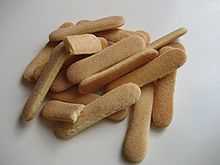Ladyfinger (biscuit)
| Ladyfinger | |
|---|---|
| Cookie | |
 Ladyfingers in transparent plastic packages | |
| Alternative name(s): | |
| Savoiardi | |
| Main ingredient(s): | |
| Sponge cake (egg whites, egg yolks, sugar, flour), powdered sugar | |
| Recipes at Wikibooks: | |
|
| |
| Media at Wikimedia Commons: | |
|
|
Ladyfingers are light and sweet sponge cakes roughly shaped like a large finger. They are a principal ingredient in many dessert recipes, such as trifles, charlottes, and tiramisu. They are typically soaked in a sugar syrup or liqueur, such as coffee for the tiramisu dessert. They are also commonly given to infants, being soft enough for teething mouths but easy to grasp and firm enough not to fall apart.
Name
These iconic biscuits have gained many colourful regional names.
- In Italy: Savoiardi (meaning "from Savoy")
- In Catalonia: Melindro
- In France: Boudoirs
- In Spain: "Bizcochos de Soletilla" ("Soletilla sponges")
- In the UK: sponge-fingers, trifle sponges or boudoir fingers
- In Portugal and Brazil: "Biscoitos de champanhe" ("champagne biscuits") or "Palitos la Reine"
- In South Africa: Boudoir biscuits
- In Persian: latifeh
- In Dutch: lange vingers ("long fingers")
- In Germany: Löffelbiskuit ("spoon cookie")
- In the Czech Republic: Cukrářské piškoty ("Konditor's biscuits")
- In Slovakia: Cukrárske piškóty ("Konditor's biscuits")
- In Slovenia: bebi piškoti ("baby cookies")
- In Bosnia/Croatia/Serbia: piškote/i
- In Turkey: kedi dili ("cat's tongue")
- In the Philippines: "broas"
- In Uruguay: plantillas
- In Argentina: vainillas
- In Chile: "Galletas de champaña" ("champagne biscuits")
- In Austria: "Biskotte" ("cookie, twice baked")
- In Romania: Pișcoturi
- In Hungary: "babapiskóta" ("baby sponge cake")
- In Indonesia : "Kue Lidah Kucing" ("cat's tongue cookies")
- In Poland: "kocie języczki" (cats' little tongues)
- In Australia: Sponge fingers
History

Ladyfingers originated in the late 15th century at the court of the Duchy of Savoy, and were created to mark the occasion of a visit by the King of France.
Later they were given the name Savoiardi and recognized as an "official" court cookie. They were particularly appreciated by the young members of the court and offered to visitors as a symbol of the local cuisine.
Preparation
Like other sponge cakes, ladyfingers traditionally contain no chemical leavening agent, and rely on air incorporated into the eggs for their "sponge" texture. However, some brands are known to contain ammonium bicarbonate. The egg whites and egg yolks mixed with sugar are typically beaten separately and folded together with flour. They contain more flour than the average sponge cake. The mixture is piped through a pastry bag in short lines onto sheets, giving the cookies their notable shape.
Before baking, powdered sugar is usually sifted over the top to give a soft crust. The finished ladyfingers are usually layered into a dessert such as the popular tiramisu.
